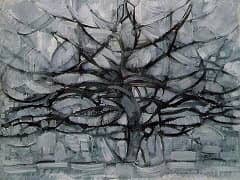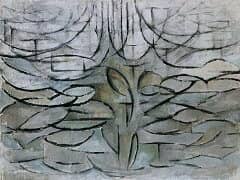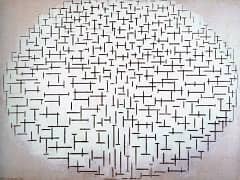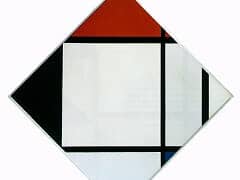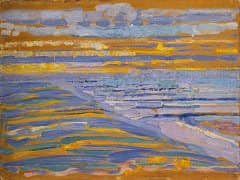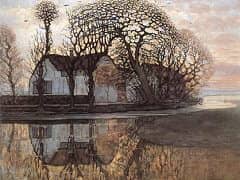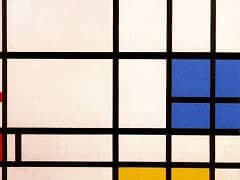Windmill, 1907 by Piet Mondrian

The version of Windmill here reproduced, one of a number of similar but different versions dating from around 1905 and 1907, is typical of Mondrian's orientation in this period of his career. At the same time the painting shows a favorite theme of his while he was in the Netherlands: windmills silhouetted against an unbroken sky above a low horizon. This theme even recurs in the dialogues on modern art that he published in De Stijl, and in which he defended the right to existence of an art no longer bound down to a subject.
Together with the series of works based on the theme Farmhouse at Duivendrecht, this 1907 Windmill embodies the features then representative of Mondrian's art: it is outstanding for its careful observation of detail, for its highly sensitive and allusive depiction of evening light, and for the mood thereby evoked. These characteristics also apply to the work of the Hague school and much other nineteenth-century painting. But upon closer scrutiny we see that it was Mondrian's intention to make this observation of detail and light serve a compositional purpose. And that is what is particularly striking in this picture, what makes it a fascinating link in the chain of Mondrian's work. When one compares this canvas with many other paintings of the Hague school, and even with the other versions that Mondrian painted of the same subject, one cannot fail to realize the taut control of the composition: the division of the picture into horizontal bands, alternately light and dark, and the great dark form of the mill, a vertical thrust against these horizontal strata, its strength re-emphasized by the reflection in the water, which supports the dark silhouette like a pedestal.
"Always further," is how Mondrian termed his drive to transform his artwork. Starting in 1907, his traditional landscape compositions began to reveal a new sense of drama and light. Jan Toorop, a leading artist of Dutch Luminism, introduced Mondrian to the French Post-Impressionists. Mondrian's paintings changed dramatically as a result, integrating, for example, the bold color and brushwork of Vincent van Gogh and the pointillist technique of Georges Seurat. Even in these early works, it is apparent that Mondrian had a tendency to work in series, focusing on a singular subject. Both of these facets would be invaluable to the development of his mature, abstract style.


